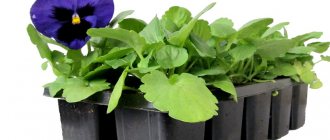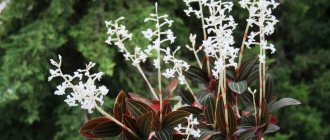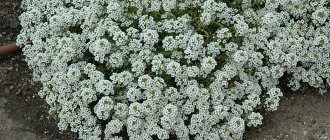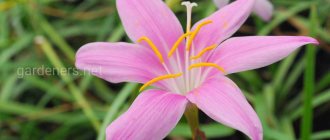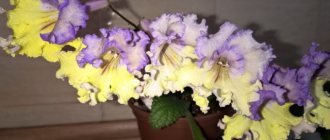In the June extravaganza of flowering, ground cover roses have no equal when they frantically weave their multi-colored dense carpets and spread them across the ground.
Thousands of white, pink, yellow, red, often fragrant, double flowers adorn the creeping or cascading shoots, turning the luxury of carpet masterpieces into a fairy-tale vision. Recently, the demand for ground cover roses of a new generation, the flowering of which begins in early June and continues until the fall, has especially increased.
At the peak of popularity among them are low, spreading roses with flexible shoots covered with shiny leaves.
Ground cover roses are especially desirable in the south, in southern dachas, where summer residents have allocated places for them to decorate low retaining walls, strengthen slopes, in rock gardens, on lawns, and containers; They were grafted onto trunks, resulting in beautiful pink trees with flower cascades, and flower borders and hedges were made from them.
Ads by
Features of ground cover roses
Ground cover roses appeared a long time ago, by crossing climbing varieties with other species. In 1919, the first variety “Max Graf” appeared. This decorative ground cover bush quickly gained popularity and gave rise to the development of new varieties. The ground cover rose owes its rapid spread to its unpretentiousness, splendor, abundance of flowering, and high decorative significance. Even in the time of Peter I, such decorative bushes decorated the area around palaces and estates. If you need to hide an unsightly corner of the garden, or plant a large landscaped area, this type of rose is simply the ideal solution. It grows quickly, has a huge number of different varieties, and makes it possible to decorate not only garden areas, but also personal plots. A powerful root system makes the ornamental bush resistant to the natural conditions of our territory.
Ground cover roses are more resistant to frost, unlike garden roses. But not all gardeners like the fact that the bud is not glass-shaped. Despite this, continuous fragrant flowering, double growth, varied colors and disease resistance have made this species very popular.
Ground cover roses spread like a carpet along the ground, rising half a meter, forming a gentle slope strewn with flowers. These bushes look especially beautiful if they have support on one side and the ability to climb upward. Among them there are varieties with long, dense, flexible branches. The ornamental bushes that were brought out first stand out for their primitiveness. With a wide range of colors, they quickly give way to modern varieties, since they have small buds and bloom once per summer. New types of scrubs delight with their flowering until autumn. At the same time, they are not inferior to the first varieties in color, they surprise with the abundance of double flowers, the choice of appearance and size.
Advantages:
- abundance of varieties;
- long flowering;
- unique carpet decoration;
- do not require special care;
- intensive growth during the growing season;
- fast rooting;
- strong immunity to diseases;
- easy to reproduce;
- frost-resistant;
- suppresses weed growth;
- growing on rocky hills and slopes;
- Possible to grow on the balcony.
Flaws:
- correct selection of fertilizers;
- in regions with severe frosts, most varieties need additional shelter;
- pruning is necessary after the first frost;
- small buds;
- petals can fade from sunlight;
- fading flowers need to be cut off;
- When choosing a seedling, give preference to the one with a powerful root system; it will take root faster.
The advantages of ground cover roses include the fact that they comfortably coexist with perennial plants. For example, with medicinal products such as sage and lavender.
Shelter for the winter
Our climate (middle zone) is characterized by severe or moderately severe winters. Representatives of the ground cover group of roses tolerate frosts well under the snow, and may even not shed their leaves until spring. However, recently weather conditions have been unstable, i.e. Temperatures can fluctuate within a day from above zero to below zero. Therefore, the possibility of freezing increases not only for roses, but also for trees. Therefore, as a precaution,
roses
covered (geotextile, agrofilm, etc.).
Varieties of scrub varieties
Depending on the size, the following varieties are distinguished among ground cover roses:
- a low-growing creeping bush about 40 cm high, no more than 1.5 m wide; 4 seedlings can be located on 1 square meter;
- a tall creeping bush grows up to 50 cm, occupies an area more than 1.5 m wide; a maximum of 2 seedlings can be planted per 1 square meter;
- small penetrating bush grows up to 60 cm upward, 1.5 m wide; 4 seedlings will fit on 1 square meter;
- a large penetrating bush up to 1 m high, slightly more than 1.5 m wide, but no more than 3 seedlings can be planted per 1 square meter.
In addition, the varieties of scrubs have the following differences:
- color spectrum;
- number of buds in the inflorescence;
- flower size;
- doubleness of petals;
- duration of flowering;
- color, lush greenery;
- richness of aroma.
Based on these criteria, the buyer has the opportunity to select seedlings of the desired type for the intended purpose:
- landscape design;
- border design;
- decorating an unsightly area of the garden;
- flowerbed decorations.
Basic landing rules
In order for ground cover roses to delight with their beauty, it is necessary to take into account the following rules when planting:
- You need to choose the right landing site. The area allocated for the bush should be well lit by the sun, especially in the morning. The lowland will not be able to provide the seedlings with normal lighting.
- Make sure the soil is suitable for this flower crop. The rose will feel better on slightly acidic chernozem soil. If the soil does not meet the required parameters, it must be adapted using special solutions.
- Make sure there is sufficient distance to groundwater. Excess moisture can be removed using drainage.
- Check whether the area is sufficient for this variety. For normal plant growth, a spacious area is needed.
Culture propagation
Ground cover roses in autumn, as in spring, can be propagated by dividing the bush. The shoots of some species take root themselves during the propagation process. If this is not desirable for a particular site, it is better to place them on a hill and make sure that the stems do not come into contact with the ground.
Cuttings are another fairly easy method of propagation. It allows you to quickly have a whole garden of luxury. To do this, make oblique cuts in the fall and place the shoots in sand or damp soil until the root system appears. It is advisable to first start young plants indoors, planting them in pots, and in the spring transfer them to open ground.
Review of the best ground cover roses
Hello
The variety is small in stature, up to 50 cm in height, growing up to 1 m in diameter. It is distinguished by its external neatness, double buds, rich dark red color, turning into cherry over time. The calyxes are medium in size - about 7 cm, the inflorescence is dense, and can have 15 flowers. The second name is “purple carpet”. Average cost: 375 rubles.
Advantages:
- lush long flowering;
- frost resistance;
- unpretentiousness;
- disease resistance;
- bright greenery;
- beautiful buds;
- acceptable price.
Flaws:
- has no smell.
Swany
The rose bush is quite tall, reaches a height of 80 cm, and is wide in diameter - almost 2 meters. The foliage is small, shiny, and retains its bright green color for a long time. The inflorescences are large and include about 20 white buds. Distinctive features are long shoots, highly full flowers with a soft pink center, and a light, refined aroma. Popular among novice gardeners. Average cost: 320 rubles.
Advantages:
- abundant flowering;
- possibility of use as a climbing rose;
- high frost resistance;
- unpretentiousness;
- delicate smell;
- perfectly decorates the garden;
- affordable price.
Flaws:
- loves slightly acidic soil.
Ahtiar
The variety is tall, can reach one and a half meters. The shoots are arched and long. The buds are large, more than 10 cm in diameter, white, double, collected in small inflorescences. The bush is suitable for planting individually or in a group, like a border hedge. A distinctive feature is the dark rich green color of the leaves, extremely abundant single flowering. Average cost: 250 rubles.
Advantages:
- exquisite tenderness of buds;
- cluster system power;
- highly decorative;
- delicate aroma;
- budget price.
Flaws:
- the smell is very strong;
- frost resistance is average.
Nadia Meillandecor
This variety was recently bred, 13 years ago. The buds are milky, cream or yellow, but can be bicolored. The flowers have a terry furry structure, have many petals, so they keep their shape perfectly. The bush is not tall, about 50 cm, it comes into force and takes root quickly, blooms profusely and for a long time. Average cost: 400 rubles.
Advantages:
- dense buds;
- strong, rapidly growing root system;
- frost resistant;
- ideal for border decoration;
- easy to care for;
- average price.
Flaws:
- According to customer reviews, this variety can take up much more space than indicated.
Les Quatre Saisons Meilland
The bush is low, reaches a maximum of 80 cm, two years old. Blooms profusely from June to September. The buds are large, deep pink, lush, and resistant to fading. The variety is popular in countries with harsh climates. Average cost: 600 rubles.
Advantages:
- flowers are densely double;
- strong immunity to diseases;
- not afraid of pests:
- fast growth;
- high frost resistance;
- faint delicate fragrance;
- unpretentious;
- retains the bud even after rain.
Flaws:
- price is above average;
- very prickly;
- It is recommended to plant next to a small support so that the flowers do not get dirty on the ground.
Ballerina
The varietal plant is characterized by the presence of a large number of flowers, fragrant, long-blooming. The bush reaches 150 cm in height, 1.75 m wide. The buds are small, up to 3 cm, dark pink in color, gradually turning into light pink. The foliage is bright green. Average cost: 480 rubles.
Advantages:
- not susceptible to powdery mildew;
- easy to grow;
- compact;
- hardy;
- blooms for a long time;
- few thorns;
- suitable for landscape design.
Flaws:
- in the bright sun the petals fade and turn pale;
- single flowers.
Amber Sun
Flowering shrub of medium height: from 70 to 100 cm, 150 cm wide. The buds are large, up to 10 cm in diameter, yellow. The foliage is dark green. The aroma is spicy, reminiscent of rose hips. Average cost: 420 rubles.
Advantages:
- persistent immunity to diseases;
- spherical lush shape of flowers;
- long flowering of each bud;
- not afraid of frost;
- keeps the shape of petals after rain;
- few thorns.
Flaws:
- the petals fade slightly;
- grows slowly.
The Fairy
The bush is 60 cm high, about 1 m wide. It has fragrant terry buds on strong flexible shoots. The variety blooms profusely from mid-summer until the autumn cold. Used in the design of alpine slides. Loves a lot of light, as well as light shade. The flowers are small, but lush, soft pink. Popular among gardeners due to its versatility. It can be used for border decoration, as a ground cover, or as a shrub. Average cost: 590 rubles.
Advantages:
- takes root quickly;
- pleasant apple aroma;
- can be grown in pots, containers;
- frost-resistant;
- persistent immunity to disease.
Flaws:
- in the northern regions it needs additional shelter for the winter;
- the price is higher than budget.
Rody
A flowering pink shrub of compact size, up to 65 cm in height, 1.3 m wide. The shoots are arched with small leaves. The buds are medium double, dense, bright in color, like strawberries. Inflorescences contain up to 10 flowers. It blooms luxuriantly from the days of May until the first frosts in autumn. Takes short breaks between blooms. Average cost: 350 rubles.
Advantages:
- bright colors;
- blooms for a long time;
- retains color in the sun;
- tolerates winter frosts well;
- affordable price.
Flaws:
- to maintain immunity requires preventive treatment;
- does not tolerate wet weather well.
Heidetraum
The rose bush is of amazing beauty because the buds have a spherical shape, which they retain even when fully opened. The most profusely flowering shrub of this species. It takes root well and grows not only in light areas, but also in slightly shady areas. The height reaches 40 cm. Long flexible shoots form beautiful arches, strewn with waxy leaves of a dark green shade, completely covering the soil. The inflorescences bloom profusely, forming a floral carpet. Average cost: 560 rubles.
Advantages:
- high decorative qualities;
- strong immunity;
- abundant long flowering;
- bright shiny foliage;
- no strong odor.
Flaws:
- needs additional shelter in winter;
- the price is slightly above average.
Snowfield
An ornamental shrub up to 50 cm high with flexible shoots, smooth, matte leaves of a rich dark green color. The buds are white and lush. The bush is distinguished by its extreme vitality and rapid rooting. Flowering is abundant, long, starting in spring and ending in autumn. The rose decorates a flower bed, alpine hill, and lawn well. Prefers bright areas of the garden. Average cost: 320 rubles.
Advantages:
- has the most delicate delicate aroma;
- compact;
- resistant to diseases and pests;
- easily endures winter;
- affordable price.
Flaws:
- fertile soil is required;
- does not like excess moisture.
Brief characteristics of varieties
| number | Variety | Height, color of petals, number of buds in inflorescence |
| 1 | Hello | Height - 50 cm, petals are dark red, turning into cherry, in an inflorescence of 6-10 buds. |
| 2 | Swany | Height - 80 cm, white petals, up to 20 buds in an inflorescence. |
| 3 | Ahtiar | Height - 150 cm, white petals, 5-8 buds per inflorescence. |
| 4 | Nadia Meillandecor | Height - 50 cm, petals are milky, cream or yellow, 3-5 buds per inflorescence. |
| 5 | Les Quatre Saisons Meilland | Height -80 cm, deep pink petals, 10-15 buds per inflorescence. |
| 6 | Ballerina | Height - 150 cm, pink petals, inflorescences from 15 to 100 buds. |
| 7 | Amber Sun | Height - 100 cm, petals are creamy-yellow, 5-8 buds per inflorescence. |
| 8 | The Fairy | Height - 60 cm, petals are pale pink, 10-30 buds per inflorescence. |
| 9 | Rody | Height - 65 cm, inflorescences have 3-12 buds of red-strawberry color. |
| 10 | Heidetraum | Height - 40 cm, deep pink petals, 10-20 buds per inflorescence. |
| 11 | Snowfield | Height - 50 cm, white petals, 3-5 buds per inflorescence. |
Beauty and benefits
Not only gardeners, but also lovers of flower flora will agree that roses are elegant garden flowers. The grace of the buds, the variety of color shades, and the unsurpassed aroma captivate with their uniqueness. Another feature of this plant is its medicinal properties. In medicine, as well as in cosmetology, the beneficial qualities of the flower are used. At home, you can independently prepare rejuvenating and nourishing masks, use infusions for washing and toning the skin. In addition, the presence of B vitamins in the petals is considered valuable. The therapeutic effect helps to quickly heal abrasions, wounds, relieve inflammation, has a calming effect, and mild anesthesia.
When choosing ground cover rose bushes, flower growers recommend taking into account the characteristics of the garden plot, its area, and landscape design. And also think about the functional purpose of the plant. Then, by giving preference to the best varieties of roses, you can quickly achieve the desired result: decorate the area, delight the eye, enjoy the fragrant aroma, pamper yourself with natural cosmetics.
If you have experience growing ground cover roses described in the rating, or a more interesting variety of this species, tell us about it in the comments.
Trimming
Creeping roses should not be radically pruned. Although in the first year the stems are shortened in order to cause tillering. It is necessary to form a bush to constantly limit the size, which is considered optimal for the variety. To prevent the occurrence of mold or fungal diseases, you need to ensure that the bush is ventilated and is sufficiently illuminated by sunlight.
Important! The shoots are cut at an angle of 45°, the distance of the cut from the nearest bud should not be less than 0.5 cm. They prune mainly those branches that are directed towards the middle of the bush and thereby thicken it greatly
If several shoots grow from one bud, the strongest one is left, the rest are removed. 5–6 years after planting, ground cover roses should be rejuvenated. Cut off all stems at a distance of 20–30 cm from the root. All cuts must be treated with garden varnish; the bush is sprayed with a one percent solution of copper sulfate.
No matter how beautiful ground cover roses are, caring for and growing most of them is not a very labor-intensive process, which is why this variety of flowers has become popular recently. They are in high demand and look very impressive in various flowerpots and flower beds. In addition, they often decorate nondescript areas.
Creeping roses are versatile and can be grown and tied like climbing roses. Planting such plants in the center of even the best grass lawn will give it much more originality. Small ground cover roses can be bred in wide containers and placed on the site in the summer, and brought into the house in the winter, turning it into a house plant for the winter.
vote
Article Rating


